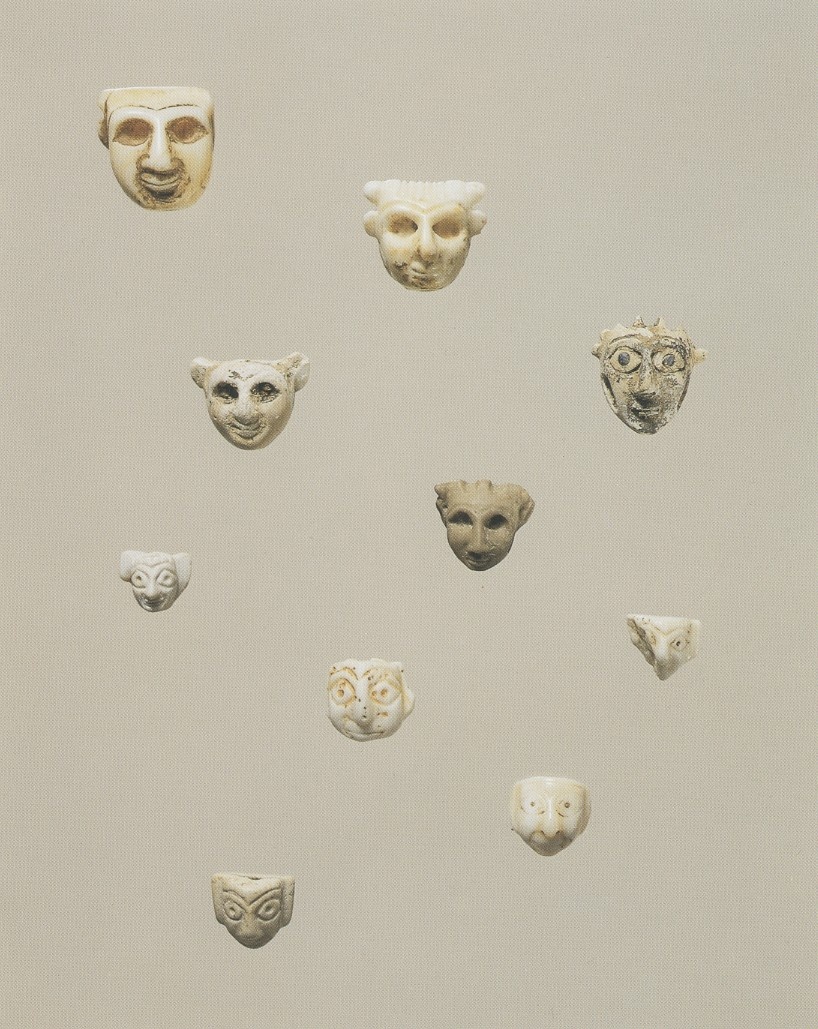
These little heads, all of the mid 3rd millennium B.C., probably served some amuletic function, perhaps to protect the wearer against evil spirits, in addition to their role as ornaments, possibly as necklace elements. Those with horns represent gods [1] and those without were probably heads of goddesses. Often found in tombs, where they accompanied their owners; sometimes strewn over temple sites [2], suggesting that they may have been worn by the priests or priestesses [3].
a. Horned head with bull's ears
Shell
H: 2.1 cm. W: 1.97 cm. D: 1.41 cm
Provenance: no indication; East Syria? [4]
(possibly region of Mari)
Mesopotamian
Ex collection: His Grace the Duke of Wellington, K.G. (1961), from the collections of the 2nd Duke of Wellington, c. 1860
Condition: pierced vertically for suspension; left ear and horn missing. Deep hollow eyes once inlaid. Below either ear representing a lock of hair [5] (see head b). Smooth, ivory- coloured surface, the whole somewhat worn, especially the right ear. Traces of earth deposit around mouth, in eyebrows, etc.
b. Horned head
Shell
H: 1.85 cm. W: 2.05 cm. D: 1.26 cm
Provenance: no indication
Sumerian. Early Dynastic III
Condition: pierced vertically for suspension. Eyes hollowed and once inlaid. Below either ear representing a lock of hair (see head a. and footnote 5). Smooth surface with incrustations: spots of dark earth limestone.
c. Head
Shell
H: 1.98 cm. W: 1.94 cm. D: 1.74 cm
Provenance: no indication; probably East Syria
Mesopotamian
Condition: grooves on head with traces of bitumen, probably once inlaid. Eyebrows grooved and perhaps once inlaid; hollowed-out recess below each ear for inlay (see head e). Eyes inlaid with shell and irises in lapis lazuli.
Slight abrasion to end of nose, half of left ear missing and right ear worn down. Surface weathered and incrusted with earth deposit and traces of blackish pigment.
d. Head
Shell
H: 1.65 cm. W: 2.01 cm. D: 1.21 cm
Provenance: no indication; probably East Syria
Mesopotamian
Condition: pierced vertically for suspension. Eyes hollow with remains of bitumen for inlays, now missing. Much worn, especially the eyebrows, nose and mouth. Traces of dark pigment, possibly once blue, and earth deposit in eyes.
A comparison which would tend to confirm a Syrian provenance is the small head [6] found in the priests' room on the site of the Temple of Ishtar at Mari.
e. Horned head with bull's ears
Alabaster-like greyish stone, limestone?
H: 1.53 cm. W: 1.67 cm. D: 1.1 cm
Allegedly from Syria, possibly region of Mari
Mesopotamian
Condition: pierced vertically for suspension. Eyes and hollowed-out recess below each ear once inlaid. Smooth surface.
f. Head
Shell
H: 1.08 cm. W: 1.25 cm. D: 0.81 cm
Allegedly from Syria, possibly region of Mari
Mesopotamian
Ex collection: Count Chandon de Briailles
Condition: pierced vertically for suspension. Whole right side of face broken off. Holes for irises of eyes once inlaid. Surface smooth and worn.
g. Head
Shell
H: 1.07 cm. W: 1.22 cm. D: 0.75 cm
Provenance: no indication
Mesopotamian
Ex collection: Professor and Marie-Louise Erlenmeyer
Condition: pierced vertically for suspension. Irises once inlaid. Intact save for slight damage to lower part of right ear. Surface smooth.
h. Head
Shell
H: 1.4 cm. W: 1.48 cm. D: 0.98 cm
Provenance: no indication
Mesopotamian
Ex collection: Professor and Marie-Louise Erlenmeyer
Condition: pierced vertically for suspension. Irises hollow, probably once inlaid. Most of ears missing, much worn and pitted as though pinpricked.
i. Head
Shell
H: 1.34 cm. W: 1.36 cm. D: 0.81 cm
Provenance: no indication; probably East Syria
Mesopotamian. Early Dynastic III
Condition: pierced vertically for suspension. Irises of eyes once inlaid. Whole surface worn and very smooth resulting in the fading of the linear decoration around the eyes, the hairline across the forehead and the line of the mouth.
j. Head
Shell or stone?
H: 1.26 cm. W: 1.39 cm. D: 0.78 cm
Provenance: no indication
Mesopotamian
Ex collection: Professor and Marie-Louise Erlenmeyer
Condition: pierced diagonally for suspension from top to middle of back. Irises drilled out, possibly once inlaid. Fissured, spotted and very worn.
1 Verbal communication Prof. Pierre Amiet, 6 July 1991.
2 Parrot, A.: Mission arch*ologique de Mari I. Le temple d'Ishtar (Paris, 1956), p. 156.
3 Parrot, A.: op. cit., p. 163. These may be temple attendants and are not priests in the modern sense.
4 East Syria corresponds essentially to the Middle Euphrates region, which is Northern Upper Mesopotamia.
5 For a representation of a lock of hair in relief, though curling forward, see the marble statuette of a woman in the British Museum: Moortgat, A.: The Art of Ancient Mesopotamia (London/New York, 1969), pl. 94. Is it merely coincidence that both this head and head b, both horned and representing gods, have the locks engraved curling backward?
6 Aleppo Museum M. 366: Parrot, A.: op. cit., no. 366, p. 156, pl. 58.